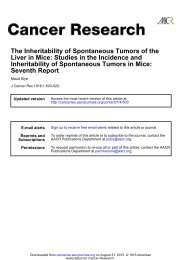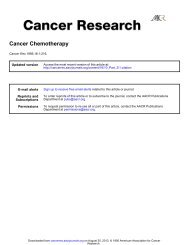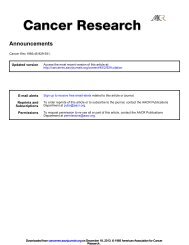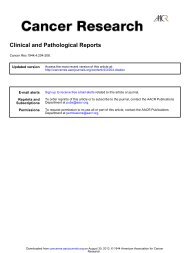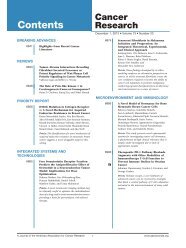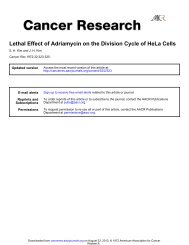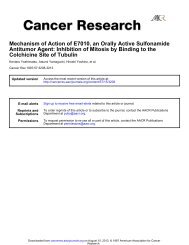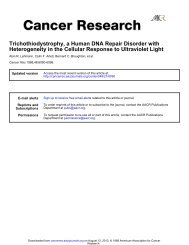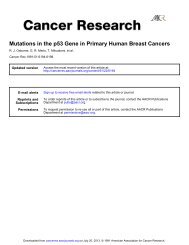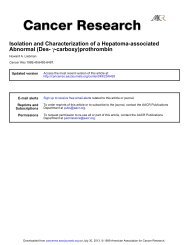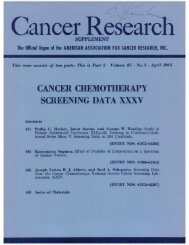Genetic Control of Resistance to Chemically ... - Cancer Research
Genetic Control of Resistance to Chemically ... - Cancer Research
Genetic Control of Resistance to Chemically ... - Cancer Research
Create successful ePaper yourself
Turn your PDF publications into a flip-book with our unique Google optimized e-Paper software.
GENETIC RESISTANCE TO MAMMARY CANCER<br />
connective tissue appears <strong>to</strong> have a higher susceptibility <strong>to</strong><br />
fibrosarcoma<strong>to</strong>us transformation, when carcinogen is directly<br />
applied <strong>to</strong> the gland, than mammary connective tissue <strong>of</strong> other<br />
rat strains more susceptible <strong>to</strong> mammary adenocarcinogenesis<br />
than the COP rat (i.e., NSD, WF, F344, ACI). This increased<br />
sensitivity <strong>of</strong> the connective tissue <strong>of</strong> COP rats is not restricted<br />
<strong>to</strong> the mammary gland, however. For example, i.p. injection <strong>of</strong><br />
DMBA in<strong>to</strong> COP females resulted in 40% <strong>of</strong> the animals<br />
developing i.p. sarcomas while only 10% <strong>of</strong> the NSD rats<br />
similarly treated developed sarcomas. The connective tissue <strong>of</strong><br />
the female COP may be inherently more sensitive <strong>to</strong> malignant<br />
transformation than similar tissue in NSD rats; however, there<br />
may be alternative reasons for these findings. When 50-day-old<br />
female COP or NSD rats are given s.c. injections in the flank<br />
<strong>of</strong> 2.5 mg <strong>of</strong> DMBA dissolved in an oil emulsion in order <strong>to</strong><br />
produce a slow release <strong>of</strong> the carcinogen, >70% <strong>of</strong> the injected<br />
animals, independent <strong>of</strong> rat strain, develop sarcomas at the site<br />
<strong>of</strong> inoculation (data not shown).<br />
These results could mean that the connective tissue cells <strong>of</strong><br />
the female COP are no more sensitive than the NSD but that<br />
when injected i.p. or directly applied <strong>to</strong> the mammary gland,<br />
DMBA might not be removed from these sites as rapidly in the<br />
COP as in the NSD female. This possibility is based upon the<br />
observation <strong>of</strong> Muggins and Fukunishi (22) demonstrating that<br />
when SD rats are given i.p. injections <strong>of</strong> DMBA no sarcomas<br />
develop. In contrast, if DMBA pellets are placed in the peri<strong>to</strong><br />
neum <strong>to</strong> maintain contact between DMBA and the connective<br />
tissue cells for an extended period <strong>of</strong> time, then peri<strong>to</strong>neal<br />
tumors <strong>of</strong> the connective tissue were universally induced. Fur<br />
ther support for this possibility is the observation that when<br />
female rats <strong>of</strong> both COP and NSD strains are given s.c. injec<br />
tions <strong>of</strong> MNU which very rapidly decomposes spontaneously<br />
[i.e., biological half-life approximately l h (23)], neither strain<br />
develops any sarcomas at the site <strong>of</strong> injection.<br />
Regardless <strong>of</strong> whether the observed differences in the suscep<br />
tibility <strong>of</strong> the connective tissue between COP and NSD females<br />
are due <strong>to</strong> differences in the cells themselves or <strong>to</strong> differences<br />
in clearance rates for the carcinogen in different connective<br />
tissues <strong>of</strong> these strains, there still remains the important obser<br />
vation that there is a unique dicho<strong>to</strong>my <strong>of</strong> resistance versus<br />
susceptibility in the mammary epithelium versus connective<br />
tissue in the female COP rat. <strong>Genetic</strong> breeding analysis dem<br />
onstrated that the resistance <strong>of</strong> the mammary epithelium <strong>of</strong> the<br />
female COP rat <strong>to</strong> DMBA and MNU is due <strong>to</strong> the mendelian<br />
inheritance <strong>of</strong> a dominant au<strong>to</strong>somal genetic alÃele.The inher<br />
itance <strong>of</strong> a single copy <strong>of</strong> this resistance alÃeleis able <strong>to</strong> prevent<br />
both the DMBA and MNU induced development <strong>of</strong> mammary<br />
adenocarcinomas in F, hybrids produced by cross-breeding<br />
COP rats <strong>to</strong> either <strong>of</strong> the highly susceptible NSD or WF strains.<br />
While resistance <strong>of</strong> the mammary epithelium <strong>of</strong> the female<br />
COP rat is controlled by a single dominant au<strong>to</strong>somal alÃele,<br />
susceptibility <strong>to</strong> DMBA induced mammary adenocarcinomas<br />
in the highly susceptible WF rats has been demonstrated by<br />
Gould (30) <strong>to</strong> be due <strong>to</strong> a series <strong>of</strong> codominant au<strong>to</strong>somal<br />
alÃeles.Since F, hybrids between the WF and COP rats are<br />
resistant <strong>to</strong> DMBA induced mammary adenocarcinogenesis,<br />
this suggests that the COP resistance alÃelemay be an epistatic<br />
alÃelecapable <strong>of</strong> suppressing the expression <strong>of</strong> the several<br />
normally codominant susceptibility alÃeles.This would be anal<br />
ogous <strong>to</strong> the ability <strong>of</strong> the albino alÃele,when present as the<br />
homozygous recessive ce alÃeles,<strong>to</strong> suppress the expression <strong>of</strong><br />
a series <strong>of</strong> dominant (e.g., agouti) and recessive (e.g., hooded)<br />
alÃelesresponsible for coat color in the rat (31). Studies are<br />
presently under way <strong>to</strong> determine if the genetically controlled<br />
resistance <strong>of</strong> the female COP rat <strong>to</strong> chemically induced mam<br />
mary carcinogenesis is due <strong>to</strong> an intrinsic resistance <strong>of</strong> the<br />
mammary epithelial cells themselves or <strong>to</strong> some general host<br />
systemic fac<strong>to</strong>r (e.g., systemic hormonal environment, etc.)<br />
which secondarily induces the mammary epithelial cells <strong>to</strong><br />
become resistant.<br />
ACKNOWLEDGMENTS<br />
The studies reported in this paper would not have been possible<br />
without the continuous expert assistance <strong>of</strong> Susan P. Dalrymple. The<br />
gifted and enlightened help <strong>of</strong> Ruth Middle<strong>to</strong>n in the completion <strong>of</strong><br />
this manuscript is likewise gratefully acknowledged.<br />
APPENDIX<br />
If a single dominant au<strong>to</strong>somal alÃeleis responsible for the resistance<br />
<strong>of</strong> the COP mammary epithelial cell <strong>to</strong> DMBA, then the genotype with<br />
regard <strong>to</strong> this resistance alÃeleshould be RR for the COP and rr for the<br />
NSD rat. Thus the female F, rat produced by crossing NSD and COP<br />
rats would have the heterozygous Rr genotype. The gametes <strong>of</strong> these<br />
Fi hybrid rats would have 2 possible configurations <strong>of</strong> alÃeles(i.e., R or<br />
r) and thus there are 4 possible genotypes in the F2generation; however,<br />
since two <strong>of</strong> the F2 genotypes are equivalent phenotypically <strong>to</strong> the FI<br />
phenotype (i.e., Rr and rR) there are only 3 possible phenotypes. Thus<br />
by mendelian principles, the genotypes <strong>of</strong> the F¡generation will segre<br />
gate in<strong>to</strong> a 1 RR:2Rr.l rr ratio. Since the RR and Rr genotypes should<br />
both show the phenotype <strong>of</strong> resistance if resistance is controlled by a<br />
single dominant au<strong>to</strong>somal alÃele,0.77 mammary adenocarcinoma/rat<br />
would be expected in the F2 generation [i.e, <strong>of</strong> four F2 rats, one rat<br />
should have 0 mammary cancers since it has the COP RR genotype,<br />
one rat should have 2.48 mammary cancers since it has the NSD rr<br />
genotype, and two rats should have 0.3 cancer each since they are <strong>of</strong><br />
the F, hybrid Rr genotype; 0 + 2.49 + (2 x 0.3 mammary cancers) =<br />
3.08/4 rats = 0.77 mammary adenocarcinoma/rat].<br />
If two codominant au<strong>to</strong>somal alÃelesare involved in COP mammary<br />
epithelial cell resistance <strong>to</strong> DMBA, then the genotype with regard <strong>to</strong><br />
these resistance alÃeleshould be R,R¡R2R2 for the COP and r,r, r2r2<br />
for the NSD rat. Thus the female Ft rat produced by crossing NSD<br />
and COP rats would have the heterozygous R,rt R2r2 genotype. The<br />
gametes <strong>of</strong> these I-, hybrid rats would have 4 possible combinations <strong>of</strong><br />
alÃeles(i.e., R,R2, R\r2, rtR2, or r,r2) and thus there are 16 possible<br />
genotypes in the F2 generation. All <strong>of</strong> these genetic combinations except<br />
for the NSD rtrt r2r2genotype would be phenotypically resistant if the<br />
resistance alÃeleswere codominant and thus only 1 <strong>of</strong> 16 animals in the<br />
1: generation should be as highly susceptible as the NSD parental line.<br />
Thus the F2 generation should develop 0.42 mammary adenocarci<br />
noma/rat if the resistance were due <strong>to</strong> 2 codominant au<strong>to</strong>somal alÃeles<br />
(i.e., <strong>of</strong> 16 rats, 1 should have 0 cancers since it would have the COP<br />
R¡R,R2R2 genotype, one rat should have 2.48 cancers since it would<br />
have the NSD rtr} r2r2genotype, and 14 rats should have no more than<br />
0.3 cancer each since they are <strong>of</strong> the heterozygous genotype; 0 + 2.48<br />
= [14 x 0.3 mammary cancers] = 6.68/16 rats = 0.42 mammary<br />
adenocarcinoma/rat.<br />
If three codominant au<strong>to</strong>somal alÃelesare involved, the genotype<br />
should be R,R, R2R2 RiR] for the COP and r,r, r2r2 r,r, for the NSD<br />
rats. The FI hybrid would thus be R,r, R2r2R}r}and the gametes <strong>of</strong> the<br />
FI hybrid would have 8 possible combinations <strong>of</strong> the alÃelesand thus<br />
there are 64 possible genotypes in the F2 generation. All <strong>of</strong> the genetic<br />
combinations except for the r¡r,r2r2r3r3genotype would be phenotyp<br />
ically resistant if the alÃeleswere all codominant and thus only 1 <strong>of</strong> 64<br />
female rats in the F2 should be as highly sensitive as the NSD parental<br />
line. Thus the F2 generation should develop 0.33 mammary adenocar<br />
cinoma/rat if 3 codominant au<strong>to</strong>somal alÃelesare involved (i.e., <strong>of</strong> 64<br />
rats, 1 should have 0 cancers since it would have the COP RtRi R2R2<br />
R)Ri genotype, 1 rat should have 2.48 cancers since it would have the<br />
NSD r,r, r2r2r}r} genotype, and 62 rats should have no more than 0.3<br />
cancer each since they are <strong>of</strong> the heterozygous genotype; 0 + 2.48 +<br />
3962<br />
Downloaded from<br />
cancerres.aacrjournals.org on February 22, 2013<br />
Copyright © 1986 American Association for <strong>Cancer</strong> <strong>Research</strong>




